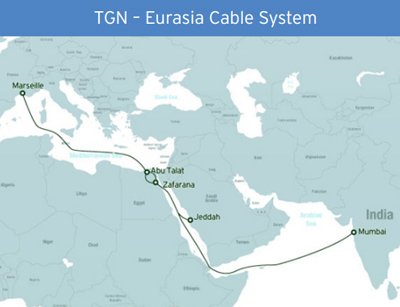Tata Communications has completed what it said is the world’s first round-the-world optical fiber cable which links Mumbai directly with Paris, London and Madrid through Egypt.
It said the Eurasia (TGN-EA) cable gives Tata, which built the last leg of the 9,280km cable with SEACOM and Telecom Egypt, complete control over a 92ms network with 2Mbps to 10Gbps availability.
Egypt was its final link for the network which will cater to a rise in voice and data transmission, linking to TGN-Gulf for connectivity from the Middle East.
Tata Communications managing director Vinod Kumar said Tata will also offer city-to-city connections, expanding beyond traditional landing stations, making communications more cost effective and allowing faster time to market for connectivity solutions.
“This is a landmark moment for Tata Communications as we officially launch the world’s first wholly owned global submarine cable network as a complete and robust ring around the world,” Kumar said.
“Our customers, whether a European auto-manufacturer, an Asian hotel group or a large US financial services firm, need to compete in global markets and are demanding faster and more reliable worldwide connectivity.”
Tata Communications has also been gathering information on the rising importance of the emerging markets.
It said a survey of 1,600 business leaders from ten global emerging and developed markets showed that of US companies alone, 51% of businesses are looking to China for growth, 39% India and 62% Brazil. The UK is heavily looking to Poland, with 19% of respondents saying they were investing in growth plans there.
Government regulation in emerging markets, however, was a concern for 18% of companies, a lack of communications and digital infrastructure worried 11% and trouble finding skills staff was a concern for 14% of respondents.
"For companies to capitalize on that potential we need to see greater levels of investment in the infrastructure that is essential to support it,” Kumar said.
“That will inevitably require more focus on developing talent and innovative thinking in markets that can have less educational investment in those areas.”

